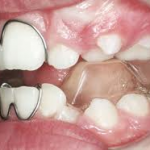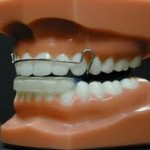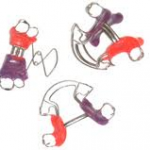Functional jaw orthpaedics is treatment with functional appliances making use of forces created by the head and neck musculature to bring about the desired dental, facial, and functional changes.
Functional appliances are removable or fixed [cemented] appliances that alter the posture of the mandible [lower jaw] and transmit the forces created by the resulting stretch of the muscles and soft tissues and by the change in the neuromuscular environment to the dental and skeletal tissues to produce movement of the teeth and modification to the growth of the jaws and lower face.
The ideal age for the use of functional appliances is between ages seven and eleven, when the cooperation level is the highest. However, functional appliances can be utilized as early as age 4, if the upper jaw is too narrow and is having a negative effect on the child’s breathing and speech. Arch Development (functional appliances) can also be used in adults to develop the arch to a more normal shape and size before applying the braces.
The use of functional appliances can reduce the time the child must wear fixed braces and also can reduce the need for the extraction of permanent teeth. Functional appliances develop the dental arches so that all the permanent teeth can erupt, which ensures an outstanding profile, broad smile and healthy jaw joints.
The most used functional appliances are the bionator, twin block, and biobloc removable functional appliances and the MARA fixed functional appliance from amongst the many type of functional appliances available to us. But – and this is important – functional appliances are not used for every patient – as some dentists would have you believe! Perhaps it is used in 40% of our cases – and that’s only in those patients with an ‘overshot’ or ‘undershot’ jaw. Where teeth are crowded, but the jaw size and relationship is o.k., then functional appliances are neither recommended nor used.
The Bionator appliance is a present day version of the Andresen Monoblock first used 100 years ago. The Bionator is designed to hold the lower jaw in its correct [class 1] relationship with the upper jaw. Over the 12 month period the bionator is worn, the muscles adapt to the corrected bite position while, depending on the version of the Bionator that is prescribed, the lower jaw moulds into its new position. Remember that the child’s head is growing – we don’t ‘grow jaws’ with functional appliances – we modify the jaw growth to the optimal shape and relationship – and that may enhance the jaw size over that of an untreated child. The Bionator ‘floats’ in the mouth. It is not normally clipped onto any teeth. Therefore it is the ideal appliance for the child to wear while the baby teeth are falling out and being replaced by permanent teeth [over the 8 to 12 year age period]. The Bionator is worn full time – day and night – apart from swimming, active sports, and eating. If the appliance is not worn at least 20 hours a day, then it simply will not achieve the changes we require.
The Twin Block appliance, like the Bionator, corrects the irregular jaw relationship into a correct [class 1] relationship. The Twin Block appliance was developed by Dr William Clark, a Scottish Orthodontist, over the 1970s and 80s. It consists of upper and lower jaw removable appliances that have plastic blocks covering the back teeth. These blocks force the lower jaw to bite into the ideal relationship with the upper jaw. It is usually worn for twelve months and, because it is in two parts and is clasped to the teeth, it should be worn during eating. Twin Block is also frequently used for adult patients who have jaw joint disorders.
The Biobloc appliance was developed by Dr John Mew, an English Orthodontist, and truly a man ahead of his time. The Biobloc is an ideal appliance for correcting the receeding lower jaw in the younger child – the 6 to 8 year old.
Orthodontists tend to limit themselves to treatments with fixed appliances [braces]. Braces are very good at moving teeth, but are not very good at modifying the jaw shapes or relationships. Removable appliances – including functional appliances – are designed to do just this. Therefore, while other dentists may say “your teeth are too big for your jaw [now that’s nonsense if I ever heard it!] and we will have to “sacrifice” [aka extract!] some of them”, we are able to say “your jaws haven’t grown properly so now your teeth don’t fit. Let’s modify the shape and relationships of your jaws so your teeth fit – without removing any of the teeth”.
And the functional group of appliances comes into their own where the jaws don’t line up. For example, the ‘undershot’ jaw, which is commonly the result of thumb sucking or the deviate swallow, can be easily corrected with functional appliance techniques. However, those orthodontists who choose not to use this simple and effective therapy are likely to recommend surgery to the jaws to correct the ‘weak chin’ appearance. This is an extremely invasive and expensive procedure with all the risks of surgery attached. Which would you prefer for your child: $20,000 for surgery or $5,000 for 12 months wearing a somewhat bulky but effective dental appliance?


